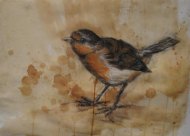Tags
canoes, Grace Lee Nute, hivernant, homme du nord, La Vérendrye, Lewis Parker, Simon Fraser, voyageurs, W. J. Phillips, York Factory

“Voyageurs at Dawn” by Frances Anne Hopkins, (1871) (1838–1919)
Grace Lee Nute, a pioneer
Several books have been written about the voyageurs, but Grace Lee Nute is our pioneer. She published her The Voyageur in 1931 (D. Appleton and Company). That book is still one’s best reference.
The Voyageur‘s clothes
At the beginning of her second chapter, Nute quotes missionnary Sherman Hall:
[m]y man dresses himself in the habit of a voyageur, that is, a short shirt, a red woolen cap, a pair of deer skin leggins which reach from the ancles a little above the knees and are held up by a string secured to a belt about the waiste, the aziōn [breech cloth] of the Indians, and a pair of deer skin moccasins without stocking on the feet. The thigh are left bare. This is the dress of voyageurs in summer and winter.[i]
As Grace Lee Nute writes, there are missing items: “a blue capote, the inevitable pipe, a gaudy sash.” The gaudy sash is “une ceinture fléchée,” a wool belt with an arrow (une flêche) design, made by French Canadians. It resembles the Irish woven belt but is wider and features the arrows.
Nute adds that the voyageur also wore a “gay beeded bag or pouch hung from the sash,” quite similar to the Scottish Highlander’s hair horse sporran. The voyageur stood out in a crowd.
Dr Bigsby, whom we will meet in my next voyageur post,
was disappointed and not a little surprised at the appearance of the voyageurs. On Sundays, as they stand round the door of the village churches, they are proud dress fellows in their parti-coloured sashes and ostrich-feathers; but here they were a motley set to the eye: but the truth was that all of them were picked men, with extra wages as serving in a light canoe [ii]

“Quetico Superior Route, passing a Waterfall“ by Frances Ann Hopkins (The Canadian Encyclopedia)
A Hierarchy among Voyageurs
There was a hierarchy among voyageurs. We had:
- hivernants (winterers): they stayed during the winter, trading and manning the “fort;”
- hommes du Nord (northern men): outstanding voyageurs who travelled further inland and opened up Forts from Athabasca to Fort Vancouver, established by the Hudson’s Bay Company in 1821. Sometimes these voyageurs accompanied explorers such as Pierre Gaultier de Varennes, sieur de La Vérendrye (17 November 1685 – 5 December 1749) and his four sons and Simon Fraser (20 May 1776 – 18 August 1862), an employee of the North West Company until its merger with the Hudson’s Bay Company in 1821.
- mangeurs de lard (pork-eaters), who went back and forth between Montreal and trading posts such as Grand-Portage.
The Canoes
One voyageur song is entitled “Épouser le voyage,” or to marry the voyage. The voyageur saw his work as a profession. As for the canoe, it was his home. Voyageurs travelled in their canoe and the canoe was the voyageur’s roof for the night. He slept underneath his upside-down canoe.
Origins of the Canoe
A voyageur learned how to make a canoe from what he could find in the wood. The birchbark canoe was of course borrowed from the Amerindians, but it was pointed out to me that there is a resemblance between the Longships used by Vikings and the York boat. However, the York boat was a boat, not a canoe. Yet the canoe resembled the Longships, except that it was relatively small. Europeans have long fished off the coast of Newfoundland and Labrador. There is a pre-history to history (recorded history) just as there is an oral tradition preceding the written tradition.
In Newfoundland, there is a town named Port aux Basques, which would indicate that Basques fishermen probably fished nearby or used the channel located close to Port aux Basques. The Trans-Canada highway ends, or begins, at Port aux Basques.
Voyageurs used birchbark canoes:

Making a Birch Bark Canoe (Photo credit: The Canadian Encyclopedia)
“In building a canoe, bark is stripped from the birch, placed inside a staked frame, sewn and attached. Ribs are fixed in position and seams sealed with spruce gum (artwork by Lewis Parker).” [iii]
—ooo—
There were several types of canoes used by voyageurs, but the first two were the most important.
- “The famous canot du maître or canot de Montréal, on which the fur trade depended, was up to 12 m long and carried 6 to 12 crew and a load of 2300 kg over the route from Montréal to Lake Superior.” [iv]
- “The smaller canot du nord or North canoe carried a crew of 5 or 6 and a cargo of 1360 kg over the smaller lakes, rivers and streams of the Northwest.” [v]
- The canot bâtard or bastard canoe was a mid-size canoe.
However, voyageurs also used Amerindian canoes.
- “The birchbark canoe of the Algonkian peoples was ideal for travel by rivers and lakes separated by narrow watersheds or portages (artwork by Lewis Parker).” [vi]
- “The Kootenay-Salish canoe was built for the rapid rivers of southern BC, with both ends extending out under the water (artwork by Lewis Parker).” [vii]

The Algonkian Canoe, Lewis Parker (Photo credit: The Canadian Encyclopedia)
The York Boat was named after the Hudson’s Bay Co’s York Factory. “It was one of 3 types of inland boats (the others being scows and sturgeon-heads) used by the HBC, and the most suitable for lake travel.” [viii]

York Boats on Lake Winnipeg by W. J. Phillips (Photo credit: The Canadian Encyclopedia [courtesy Glenbow/4615])
_________________________
[i] Grace Lee Nute, The Voyageurs (St Paul: Minnesota Historical Society, 1987 [1931]), p. 13.
[ii] Op. cit., p. 15.
[iii] “Birchbark Canoes,” The Canadian Encyclopedia. <http://www.thecanadianencyclopedia.com/en/article/birchbark-canoe/>
[iv] loc. cit.
[v] loc. cit.
[vii] loc. cit.
[viii] “York Boat,” The Canadian Encyclopedia <http://www.thecanadianencyclopedia.com/en/article/york-boat/>
—ooo—

The Tonquin, 1811















 © Micheline Walker
16 January 2012
© Micheline Walker
16 January 2012
